20+ Years Experience
Specialist EICR Testing

To properly prepare for an EICR test, it is important to follow a series of steps to ensure a smooth process and accurate results. Here’s a concise guide on how to make the necessary preparations:
It is important to note that each property and situation may require additional preparation steps. Make sure to consult with a qualified electrician or the inspection service provider for any specific guidelines or requirements.
Remember, proper preparation is essential to ensure a successful EICR test that accurately evaluates the safety and compliance of your electrical installation.
To avoid any delays or potential safety concerns, take the time to thoroughly prepare for the upcoming EICR test. By doing so, you will have the peace of mind that your electrical installation has been thoroughly inspected, ensuring the safety of all occupants and compliance with regulations.
To prepare for an Electrical Installation Condition Report (EICR) test, follow these steps:
Collaborate with the electrician, providing any required assistance and clarifications, to achieve accurate results and address any potential issues efficiently. By adhering to these suggestions, you can ensure a seamless preparation for the EICR test and maintain electrical safety in your property.
Regular maintenance and prompt repairs will help minimize the risk of interruptions. While preparing for potential disruptions, it is crucial to ensure that your strategy complies with safety regulations and industry standards.
Taking these proactive measures will help you address interruptions effectively and minimize any impact they may have on the EICR test.
When it comes to time considerations for preparing for an EICR test, there are a few important points to keep in mind:
Asking the correct inquiries plays a crucial role in preparing for an EICR test. By posing relevant and targeted questions, one can gather valuable information about the process, ensuring a thorough understanding of what is involved.
This enables individuals to adequately prepare for the test, addressing any potential issues or concerns beforehand.
When it comes to asking the right questions, it is essential to focus on key areas such as the scope of the EICR test, the qualifications and experience of the inspector, and the expected timeline for completing the assessment.
Inquiring about any specific documentation or preparations needed, as well as understanding the potential consequences of an unsatisfactory result, can provide valuable insights for effective preparation.
By seeking clarification on the testing methodology, individuals can also gain a better understanding of the procedures involved and potential disruptions to their daily activities.
In addition to these important considerations, it is worth asking about the availability of any post-assessment support or guidance. Understanding the steps to rectify any issues identified during the testing process can help individuals plan and allocate resources accordingly, ensuring compliance with regulations and maintaining safety standards.
An electrical safety inspection requires visually inspecting and testing every circuit in the home. This means that all bedrooms, bathrooms, attics, sheds, and outbuildings with power need to be visited during the test.
It is crucial to provide clear access to every room to ensure a thorough check of the electrical systems.
Electricians testing the property should have access to every single electrical outlet, even those hidden behind heavy furniture.
Electrical safety checks typically take around 3 to 4 hours to complete, depending on the size of the house. However, the exact duration can vary depending on different factors.
It is important to remember that electrical safety is a serious matter, and the electricians may need additional time if required.
It’s best to allow them the necessary time to ensure a thorough inspection rather than rushing through and potentially missing something important.
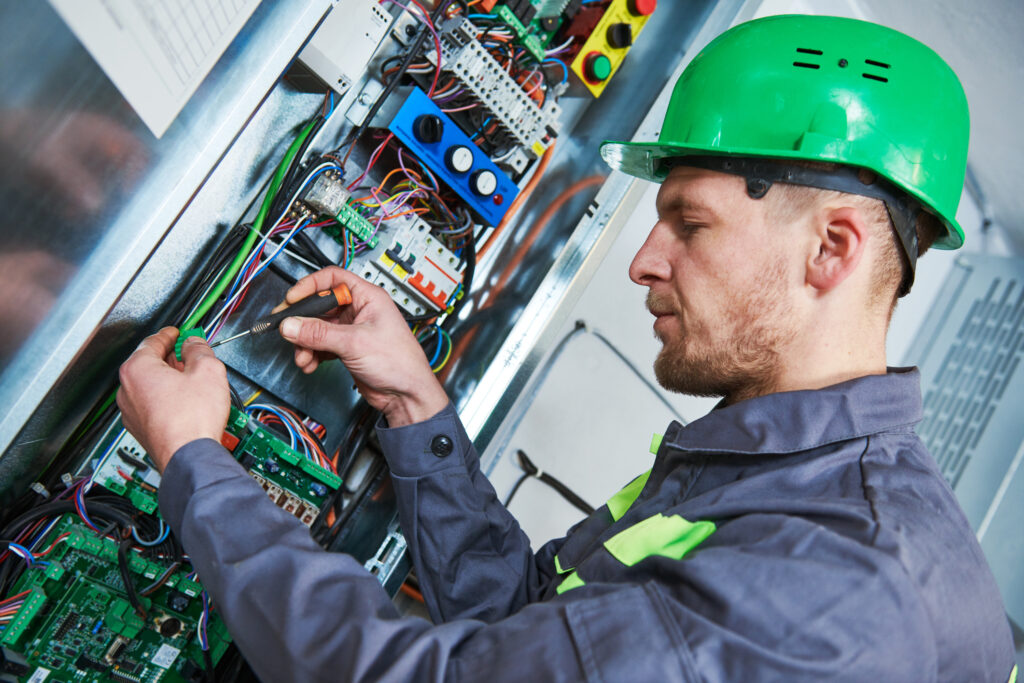
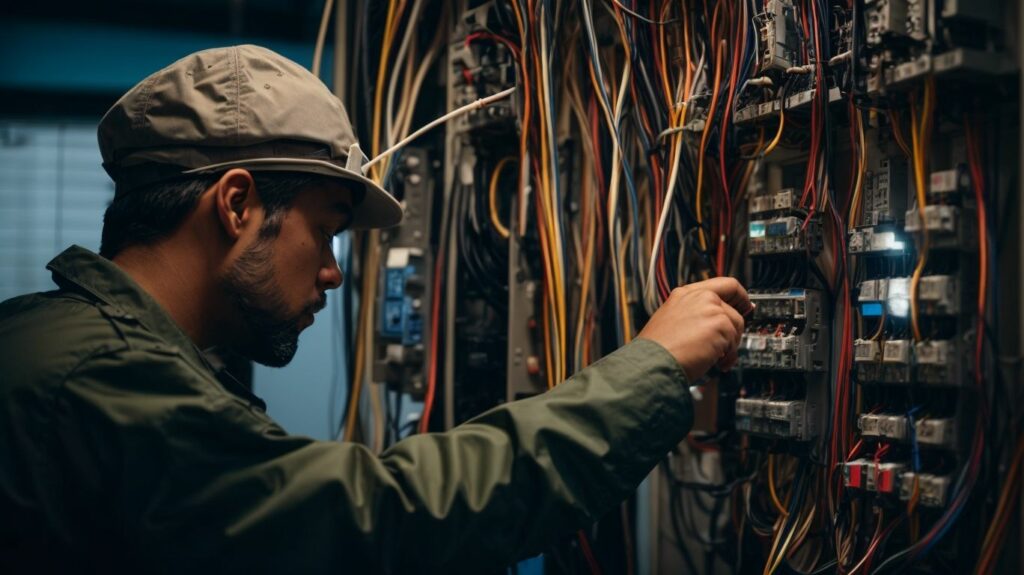
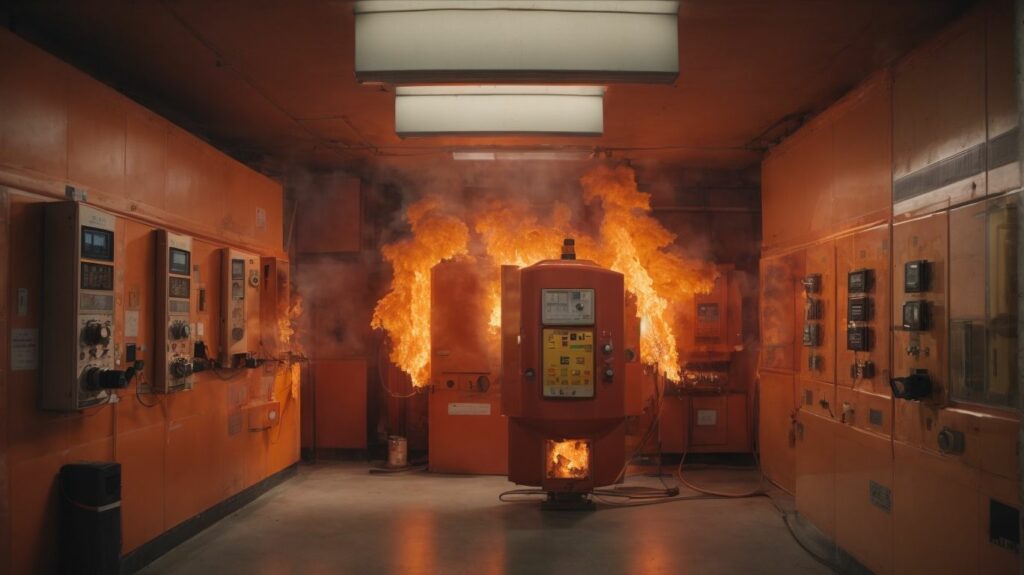

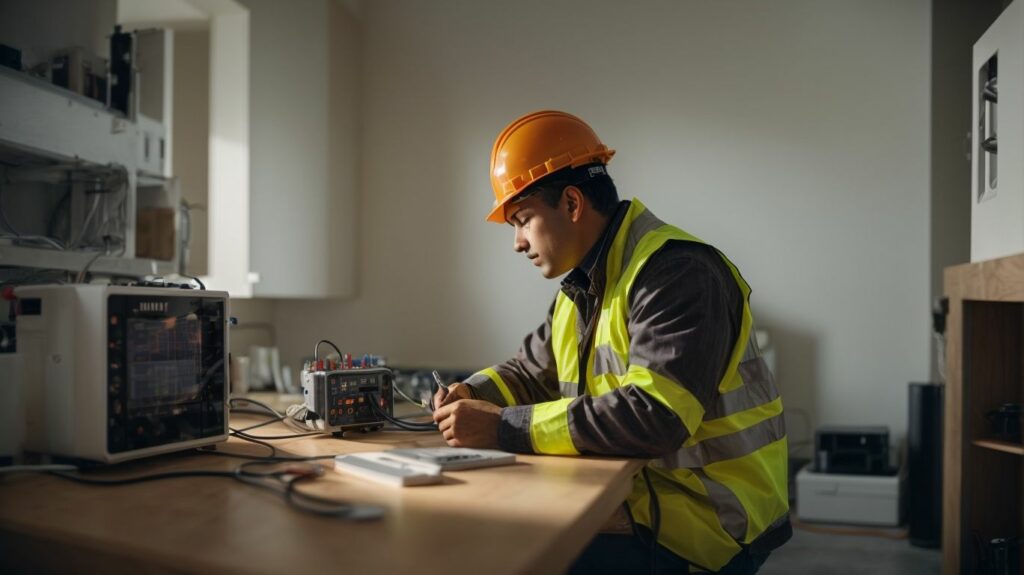
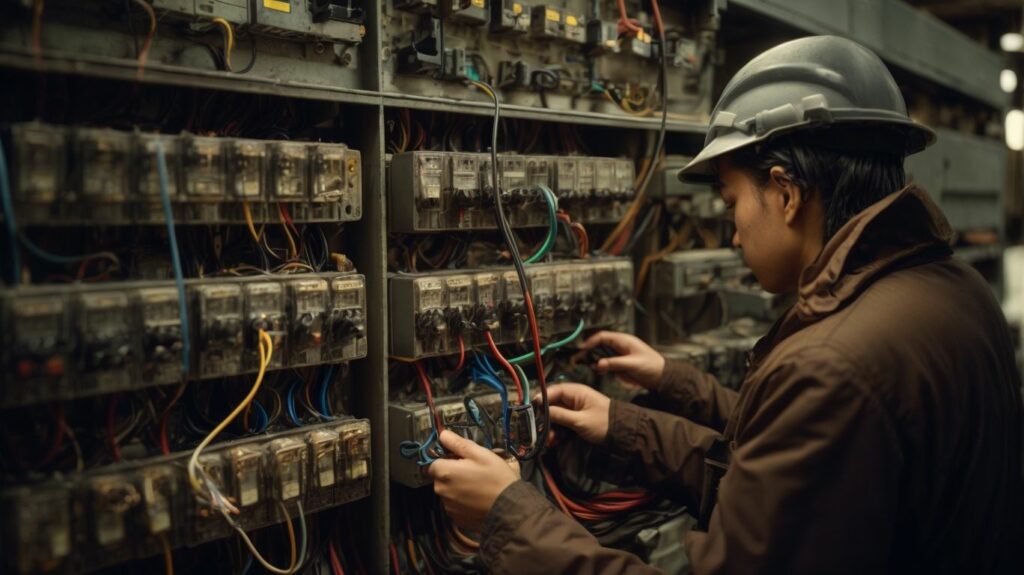
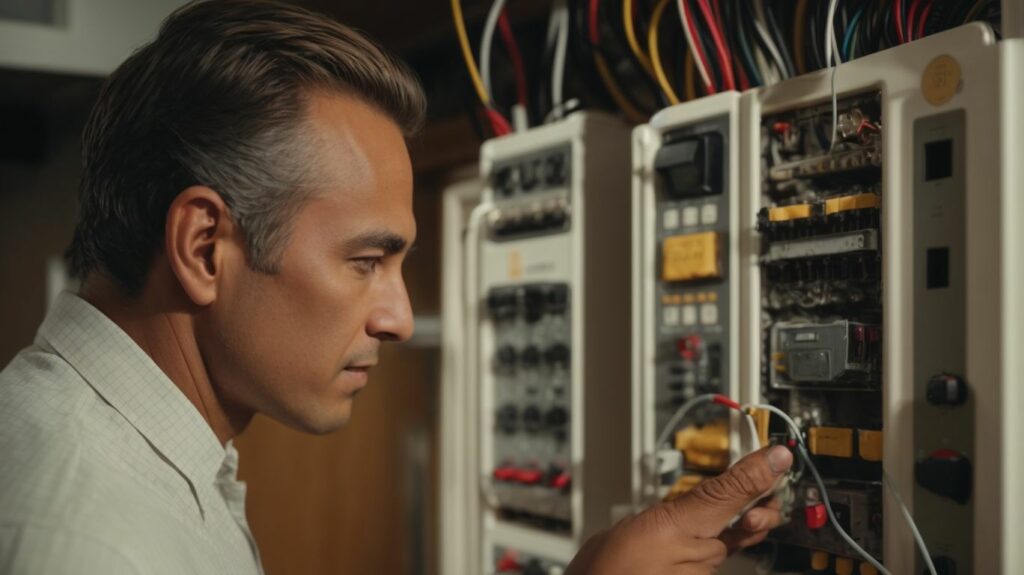



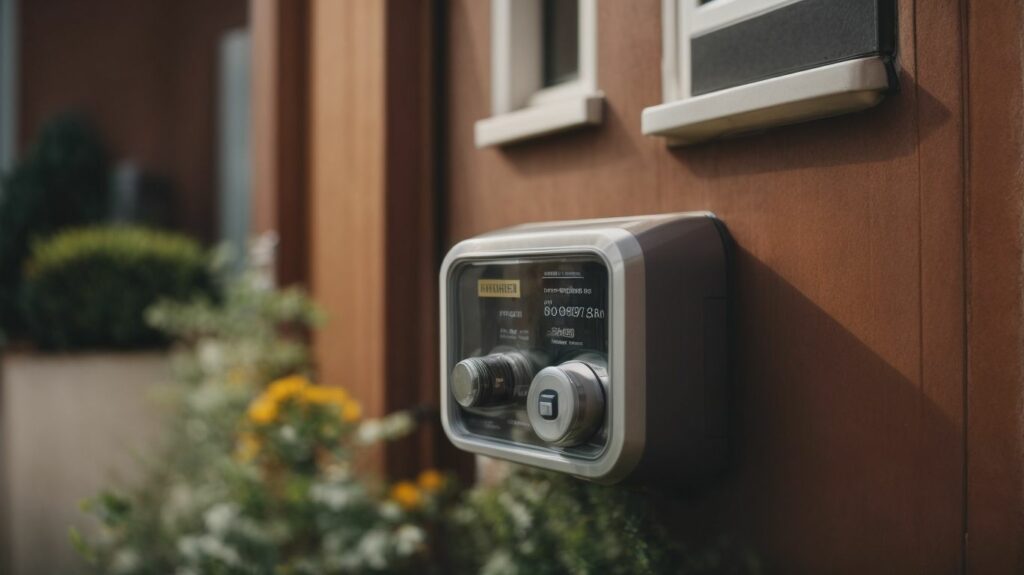


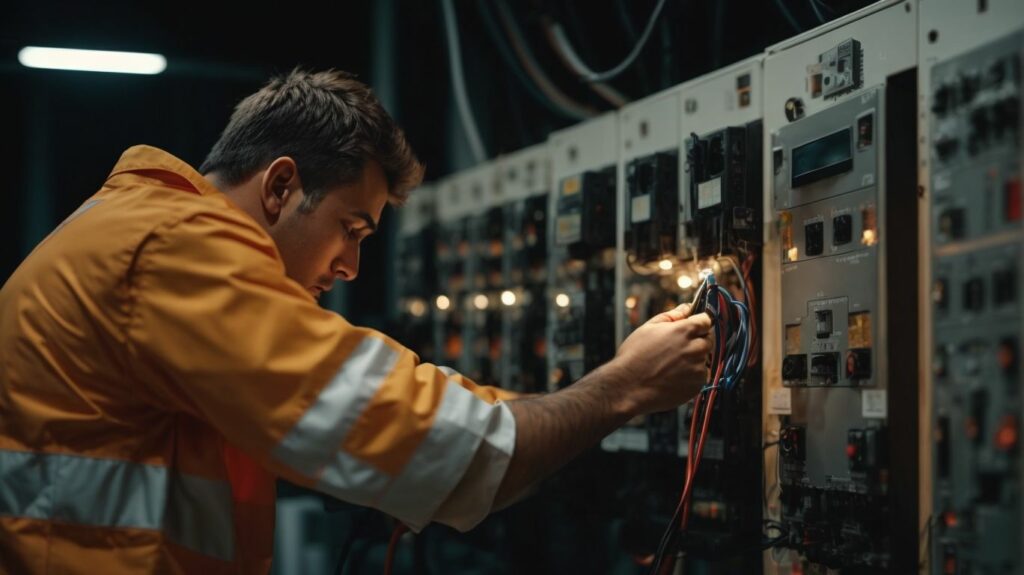
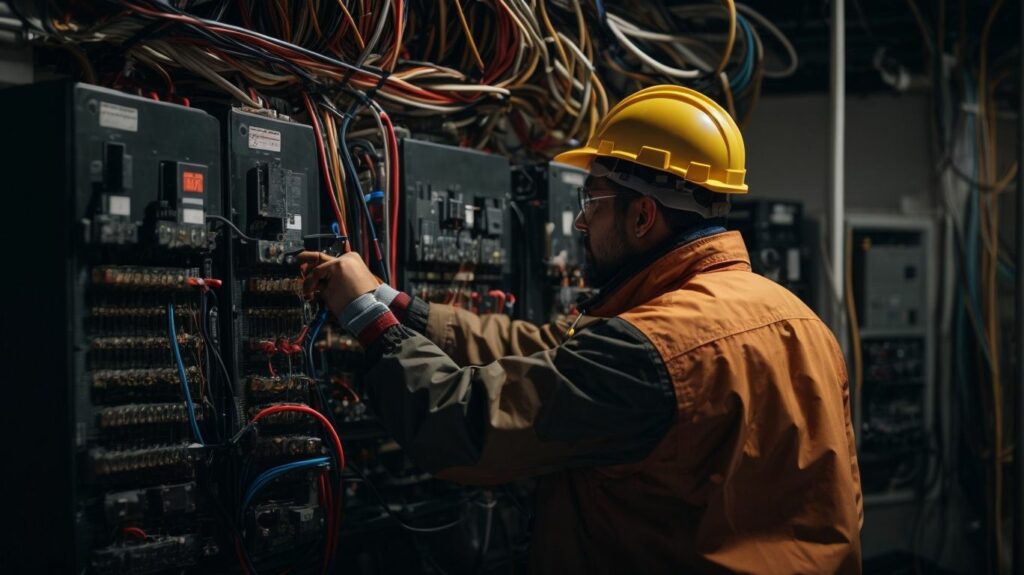
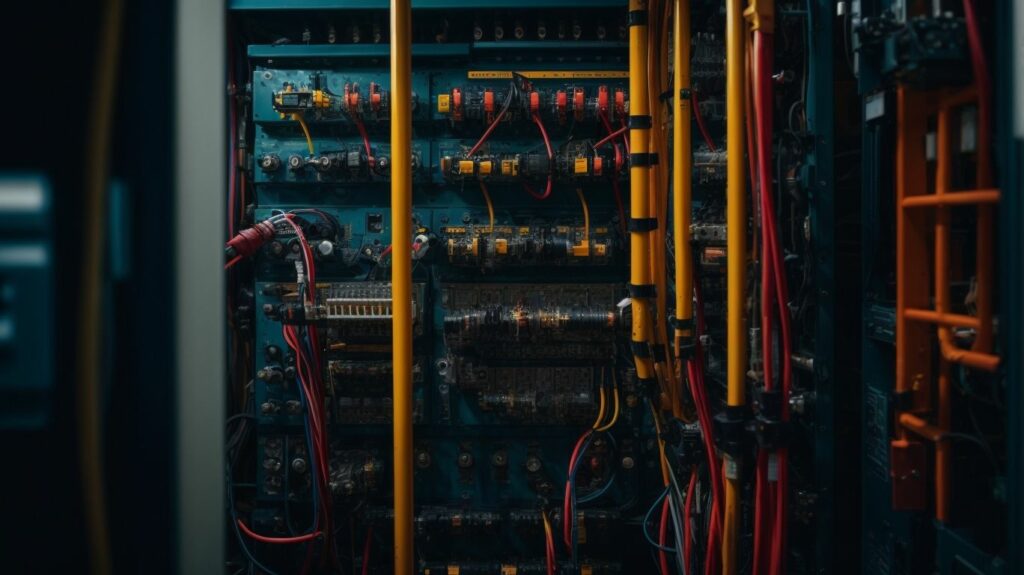


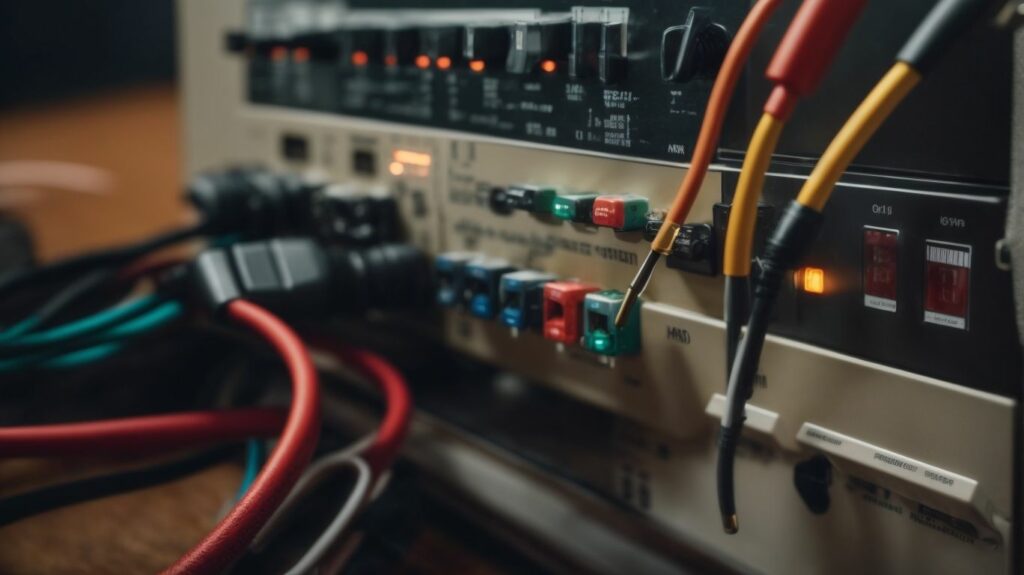
EICR and PAT testing are vital processes that ensure the safety of electrical installations and portable appliances.
EICR, or Electrical Installation Condition Report, involves a thorough assessment of the electrical system in a building, identifying any potential hazards or faults. Whereas, PAT testing, or Portable Appliance Testing, focuses on testing and inspecting portable electrical equipment.
Both EICR and PAT testing are crucial for maintaining a safe working environment and complying with legal requirements.
Continuing with this understanding, it is essential to grasp the specific details that set EICR and PAT testing apart. While EICR revolves around the inspection and assessment of fixed electrical installations, such as wiring systems and distribution boards, PAT testing is primarily concerned with portable appliances like laptops, extension cords, and power tools.
EICR and PAT testing serve different purposes. EICR testing is conducted periodically or during major renovations to evaluate the overall condition of an electrical installation. This helps identify any potential fire hazards, shock risks, or non-compliance with safety standards.
PAT testing, on the other hand, is performed more frequently and focuses on assessing the safety of individual portable appliances. It ensures that they are properly maintained and do not pose any potential risks to users.
Professionally, EICR testing ensures the condition and safety of electrical installations. This involves a comprehensive examination of the entire electrical system to detect any potential hazards or faults.
By conducting EICR testing, experts can identify any defects, deterioration, or non-compliance with safety regulations. Through meticulous inspection, professionals assess the condition of various electrical components, including wiring, sockets, switches, and distribution boards.
Moreover, this analysis encompasses the assessment of earthing, bonding, and overall electrical system functionality. It ensures that electrical installations are in optimal condition, minimizing the risk of electrical accidents, fires, or disruptions.
With safety as the top priority, EICR testing provides vital information for property owners to address any necessary repairs or improvements promptly. By taking action based on the results, individuals can safeguard their property, protect occupants, and demonstrate compliance with electrical regulations.
Ensuring the safety of portable electrical appliances is crucial, and PAT testing plays a vital role in achieving this.
This process involves assessing the electrical safety of devices like laptops, tools, and kitchen equipment to identify potential faults, such as faulty wiring or insulation issues.
By conducting regular PAT testing, businesses and individuals can mitigate the risk of electrical accidents and ensure the safety of their employees, customers, and properties.
During PAT testing, qualified engineers use specialised equipment to conduct various tests, including visual inspections, earth continuity tests, insulation resistance measurements, and portable appliance function tests.
These tests help identify any potential electrical faults or defects, allowing necessary repairs or replacements to be carried out promptly. By adhering to PAT testing regulations and guidelines, businesses can comply with legal requirements and demonstrate their commitment to safety.
It is important to note that PAT testing serves as a preventive measure to identify potential hazards and prevent accidents, rather than a guarantee of absolute safety.
While PAT testing significantly reduces the risk of electrical incidents, it should be complemented by other safety measures, such as regular maintenance and user awareness.
PAT and EICR testing are two distinct procedures used for assessing electrical safety.
PAT testing, short for Portable Appliance Testing, involves checking electrical appliances to ensure they are safe to use.
EICR testing, or Electrical Installation Condition Report, examines the overall condition of an electrical installation, identifying potential hazards and recommending necessary repairs.
Both tests serve different purposes in ensuring electrical safety. When comparing PAT and EICR testing, it is essential to understand their specific focuses and procedures.
PAT testing primarily concentrates on individual electrical appliances, such as laptops, kettles, or power tools. By conducting visual inspections and performing electrical tests, engineers assess the safety of these appliances, looking for faults, damage, or potential risks.
EICR testing takes a broader view by inspecting the entire electrical installation in a building. This includes examining the wiring, sockets, switches, and distribution boards to identify any faults, deterioration, or non-compliance with safety regulations.
While both tests are crucial for maintaining electrical safety, their scope and objectives differ. PAT testing aims to ensure the safety of individual appliances and prevent electrical accidents due to faulty equipment.
It is typically performed on a regular basis, depending on the nature of the appliances and environment. EICR testing focuses on evaluating the overall safety of the electrical installation in a building.
It helps identify potential hazards, such as outdated wiring or faulty circuits, and provides recommendations for remedial actions.
EICR testing is generally conducted periodically or when there is a change in occupancy or significant alterations to the electrical system.
To ensure electrical safety, it is important to make informed decisions when it comes to testing. One such consideration is the difference between Portable Appliance Testing (PAT) and Electrical Installation Condition Report (EICR) Testing.
PAT testing focuses on inspecting and testing portable appliances to ensure they are safe and in good working condition. On the other hand, EICR testing involves a thorough examination of the overall electrical installation within a building.
By understanding the distinction between PAT and EICR testing, individuals can make informed decisions about which testing method is most appropriate for their specific needs. It is crucial to consider factors such as the type of equipment being used, the size of the premises, and the potential risks involved.
Furthermore, it is important to regularly carry out testing to maintain electrical safety. While PAT testing is typically recommended for appliances that are frequently moved or used, EICR testing is advisable for assessing the overall condition and compliance of electrical installations in order to identify potential hazards.



















EICR testing should only be conducted by qualified electricians due to the complexity and potential hazards involved in electrical systems.
Only qualified electricians possess the necessary knowledge, training, and certifications to perform accurate inspections and assessments.
Qualified electricians for EICR testing should have specific qualifications and certifications relevant to electrical safety and installations. These certifications ensure their competency and adherence to industry standards and regulations.
Qualified electricians have several responsibilities when performing EICR testing. Firstly, they conduct a thorough and comprehensive inspection of all electrical installations within the building, including wiring, switches, sockets, lighting, and other components.
During the inspection, any electrical issues, faults, or potential risks are identified and properly documented. This documentation is essential for creating a detailed EICR report, which outlines the current condition of the electrical installations and any required remedial actions.
Based on the findings, qualified electricians also provide recommendations for necessary remedial actions to address the identified electrical issues. These recommendations ensure that the electrical systems are brought up to the required safety standards and compliance regulations.
Hiring qualified electricians for EICR testing offers several key benefits. Firstly, it ensures compliance with safety standards and regulations, protecting both the occupants of the building and the property itself. By identifying and rectifying any electrical faults or non-compliance issues, potential risks and hazards are minimized.
Furthermore, qualified electricians reduce the risks of electrical accidents and fires by addressing any issues found during EICR testing.
Regular testing and inspections conducted by professionals help maintain the integrity and safety of electrical systems, providing peace of mind for building owners, occupants, and stakeholders.
Qualified electricians are essential in EICR testing as they ensure the safety and compliance of electrical installations. They possess the necessary expertise and knowledge to identify potential hazards, faulty wiring, and other electrical issues.
The significance of qualified electricians lies in their ability to accurately assess and carry out repairs or maintenance to prevent electrical accidents and fires.
By hiring qualified electricians, you can be assured that your electrical systems are installed, inspected, and maintained properly, thus providing peace of mind and safeguarding the wellbeing of individuals and properties.
The expertise and skills of qualified electricians are invaluable in maintaining electrical safety standards.
EICR testing should always be carried out by qualified electricians for several important reasons.
Firstly, qualified electricians possess the necessary knowledge and expertise to conduct thorough inspections of electrical installations.
They have a clear understanding of the complexities and potential risks associated with electrical systems, thereby ensuring a comprehensive assessment.
Secondly, they can accurately identify and document any electrical issues or faults, providing detailed reports for further action.
Thirdly, qualified electricians are capable of offering recommendations for remedial actions, helping to rectify any problems and ensure the safety and compliance of the electrical installation.
By hiring qualified electricians for EICR testing, you can guarantee professionalism, accountability, and adherence to safety standards.
Electricians conducting EICR testing should possess specific qualifications and certifications to ensure the safety and effectiveness of the process. These qualifications include being a registered electrician with a recognised regulatory body, such as NICEIC or ELECSA. They should have completed the necessary training and hold relevant certifications, such as City & Guilds 2391 or 2394/2395. These qualifications demonstrate their knowledge and expertise in electrical inspection and testing. By hiring electricians with these qualifications, you can trust that they have the necessary skills to accurately assess electrical installations, identify any issues, and provide recommendations for remedial actions.
A thorough inspection of electrical installations is crucial in EICR testing to ensure the safety and compliance of electrical systems. The process involves several important steps:
Qualified electricians play a vital role in identifying and addressing potential electrical hazards, ensuring the safety and functionality of electrical installations through a comprehensive inspection.
When it comes to EICR testing, qualified electricians have a vital role in identifying and documenting electrical issues. This involves several important steps:
When it comes to EICR testing, qualified electricians have a vital role in providing recommendations for remedial actions to address any electrical issues. These recommendations are aimed at improving the safety and compliance of electrical installations. Here are some suggestions for remedial actions that qualified electricians may propose:
Ensuring compliance with safety standards is essential in EICR testing. Qualified electricians have a crucial role in this process as they possess the necessary knowledge and expertise to accurately assess electrical installations. Below is a table highlighting the responsibilities of qualified electricians in EICR testing:
| Responsibilities of Qualified Electricians |
|---|
| Thorough inspection of electrical installations |
| Identification and documentation of electrical issues |
| Recommendations for remedial actions |
By entrusting EICR testing to qualified electricians, you can have peace of mind knowing that your electrical systems comply with safety standards, reducing the risks of electrical accidents and fires. It is their job to ensure that your electrical installations align with regulations, providing you with both safety and legal compliance.
Reducing the risks of electrical accidents and fires is a crucial aspect of EICR testing. Qualified electricians play a vital role in ensuring the safety of electrical installations. They conduct thorough inspections to identify any potential issues that may pose risks. By documenting these issues, they can provide recommendations for necessary remedial actions to mitigate the risks. Hiring qualified electricians for EICR testing offers several benefits, such as ensuring compliance with safety standards, reducing the risks of accidents and fires, and providing peace of mind. Remember, when it comes to electrical safety, always rely on the expertise of qualified professionals. Pro-tip: Regular EICR testing can significantly minimize the chances of electrical accidents and fires, providing a safer environment for everyone.
When it comes to EICR testing, hiring qualified electricians provides peace of mind and ensures compliance with legal obligations. These professionals have the expertise to thoroughly inspect electrical installations, identify and document any issues, and provide recommendations for remedial actions. By entrusting this task to qualified electricians, you can reduce the risks of electrical accidents and fires. Meeting safety standards gives you peace of mind, knowing that your electrical systems are in proper working order. Do not overlook the importance of hiring qualified electricians for EICR testing to fulfil your legal obligations and maintain a safe environment.
EICR Testing, also known as Electrical Installation Condition Report Testing, is a crucial process for ensuring electrical safety in your new property. It involves a thorough examination of the electrical installations, circuits, and systems within a building to identify any potential hazards or malfunctions.
For home buyers, EICR testing is of utmost importance as it helps you understand the condition of the electrical system and highlights any necessary repairs or updates that need to be addressed. This not only ensures your safety but also gives you peace of mind knowing that the electrical systems in your property are in compliance with legal requirements and regulations.
EICR testing helps ensure electrical safety by identifying potential hazards such as faulty wiring or connections, outdated electrical fixtures, or appliances that may pose a risk of electrical shock or fire. By addressing these issues, the testing helps prevent accidents and potential damage to your property.
An EICR test typically involves three steps: visual inspection, testing and verification of electrical systems, and reporting and certification of the results. If any issues are revealed during the testing, it is essential to address them promptly and engage professionals to carry out the necessary repairs or upgrades.
It is recommended that EICR testing is conducted by qualified and registered electricians who have the necessary expertise and knowledge to accurately assess the electrical installations and provide reliable reports. By ensuring EICR testing is conducted by a professional, you can have confidence in the accuracy and effectiveness of the assessment in ensuring electrical safety in your new home.
EICR testing, which stands for Electrical Installation Condition Report testing, is an essential safety measure for individuals who are planning to buy a new property. This type of testing involves a comprehensive examination of the electrical systems and installations in the property. The main objective of EICR testing is to identify any potential hazards or faults that could pose a risk to the occupants. It evaluates the safety of various components such as wiring, outlets, switches, and other electrical elements. By ensuring that the electrical infrastructure meets safety standards, home buyers can have peace of mind and minimize the risk of electrical accidents. It is highly recommended that all home buyers request an EICR test before finalizing a purchase in order to ensure the electrical safety of their new property.
Are you purchasing a new property? Wondering why EICR testing is important for home buyers? Let’s discuss the importance of EICR testing and why it is crucial for ensuring electrical safety in your new home. We will explore the purpose behind EICR testing and the legal requirements involved. Let’s uncover the reasons why EICR testing should be a priority before moving into your dream home.
Understanding the purpose of EICR testing is essential for ensuring electrical safety in properties. EICR testing aims to identify potential electrical hazards, check for faulty wiring or connections, and assess the condition of electrical fixtures and appliances. This testing is important for home buyers as it helps to uncover any electrical issues before purchasing a property, ensuring that it meets safety standards. By conducting EICR testing, potential risks can be identified and addressed, reducing the likelihood of electrical accidents or fires. It is essential to understand the purpose of EICR testing to prioritize the safety of your new property.
To meet the legal requirements for EICR testing, homeowners must ensure that they regularly inspect the electrical installations and systems in their properties. The Electrical Safety Standards in the Private Rented Sector (England) Regulations 2020 specify that landlords are obligated to carry out an EICR test every five years, or more frequently if recommended by the previous inspection. These regulations aim to guarantee that electrical installations are safe and meet the necessary standards. Failure to comply with these legal requirements can lead to penalties or prosecution. It is crucial for home buyers to confirm that the property they are purchasing has recently undergone EICR testing to ensure electrical safety and compliance with the law.
To ensure electrical safety in your new property, let’s delve into how EICR testing achieves this. We will explore the essential steps involved, which include identifying potential electrical hazards, checking for faulty wiring or connections, and assessing the condition of electrical fixtures and appliances. By doing so, we will uncover the secrets of EICR testing and how it safeguards your home from electrical risks.
Potential electrical hazards should be identified during an EICR test to ensure electrical safety. Common hazards include faulty wiring, overloaded circuits, and outdated electrical fixtures. An experienced electrician will carefully inspect the electrical system, looking for signs of wear, loose connections or exposed wires. They will also check if proper grounding has been implemented and if there are any potential fire hazards. Identifying these hazards early on can prevent accidents, electrical fires or electric shocks. Regularly checking electrical appliances for frayed cords or damaged outlets can also help identify potential electrical hazards in your home.
When conducting an EICR test, checking for faulty wiring or connections is a crucial step to ensure electrical safety. This involves a thorough examination of the electrical system to identify any potential hazards and ensure proper functioning. Here are the steps involved in checking for faulty wiring or connections during an EICR test:
By thoroughly checking for faulty wiring or connections, an EICR test helps to identify any potential risks and ensure the electrical system is safe for use.
During an EICR test, the condition of electrical fixtures and appliances is assessed through several steps:
To maintain the condition of electrical fixtures and appliances in your home, consider the following suggestions:
When it comes to EICR testing, it is crucial for home buyers to understand what it involves and how it ensures electrical safety in a new property. The process includes a visual inspection, comprehensive testing and verification, as well as detailed reporting and certification. Each step plays a vital role in uncovering potential risks and providing peace of mind for homeowners. Let’s delve into the details of an EICR test.
During the EICR testing process, the first step to ensure electrical safety in a property is the visual inspection. This step involves thoroughly examining the electrical installation.
The visual inspection serves as an initial assessment to identify any potential electrical hazards and determine the overall condition of the electrical system in the property.
During Step 2 of an EICR test, comprehensive testing and verification are carried out to ensure electrical safety in a property. This step involves several important tasks:
These meticulous tests and verifications provide a comprehensive assessment of electrical safety in a property, ensuring potential hazards are identified and addressed promptly.
Reporting and certification is the final step in the EICR testing process, ensuring that the electrical installation meets safety requirements. This step involves documenting the findings from the visual inspection and testing, and issuing a detailed report. The report includes any issues found during the testing, recommendations for improvements, and a certification indicating whether the installation is satisfactory or unsatisfactory. The certification serves as proof that the electrical installation has been evaluated and meets the necessary safety standards. It is important to hire a qualified professional to conduct the EICR testing and provide accurate reporting and certification.
An EICR test is important for identifying any electrical safety issues in a new property. If the test uncovers any issues, there are several steps that can be taken. Firstly, the homeowner should seek the advice of a qualified electrician to assess the severity of the problems. Depending on the severity, repairs or replacements may be necessary to ensure safety. It is crucial to deal with any issues promptly to prevent potential hazards, such as electrical fires or electric shocks. Homeowners can potentially negotiate with the seller to cover the costs of repairs or request a reduction in the property price. Taking proactive measures and addressing the necessary actions will help to guarantee electrical safety in the new property.
If an EICR test reveals any issues, it is advisable to:
| 1. | Consult a qualified electrician for assessment. |
| 2. | Address repairs or replacements promptly. |
| 3. | Negotiate with the seller for financial assistance. |
| 4. | Prioritize electrical safety in the new property. |
When it comes to conducting an EICR test, it is important to hire a qualified and competent electrician. Only licensed electricians who are registered with a recognised professional body should be entrusted with this task. They have the necessary expertise and training to conduct thorough inspections and identify any potential electrical safety issues. It is also recommended to choose an electrician who specialises in EICR testing to ensure that they are up-to-date with the latest regulations and standards. Hiring a qualified professional will give you peace of mind knowing that your new property is electrically safe.
An EICR (Electrical Installation Condition Report) is a safety certificate and report provided by a qualified electrician. It is important for home buyers as it helps identify potential safety issues in the property’s electrical system, ensuring the safety of occupants and avoiding potentially costly problems in the future.
It is recommended to get an EICR done when buying a house, especially for new builds or if you plan to rent out the property. It is best to have it done at the same time as your home survey, after the offer is accepted and before exchanging contracts.
An EICR conducted by a registered electrician can help uncover any electrical problems that may not be visible during a visual assessment. It provides a thorough assessment of the electrical installation’s condition, indicating if any maintenance or remedial work is needed. By having an EICR done, you can avoid costly surprises and ensure the safety of your new property.
Not having an EICR done can leave you unaware of potential safety issues within the property’s electrical system. This can lead to accidents, electrical faults, or fires, as government statistics show that around 4 people a day are injured or killed in fires related to electrical faults. An EICR helps mitigate these potential dangers.
It is important to use an electrician registered with one of the government-approved schemes, such as Penningtons Electrical Contractors Ltd or an electrician listed in the Electrical Safety Register. You can also use trusted platforms like Which? Trusted Trader to find and verify professional registered electricians.
The cost of an EICR can vary depending on the size and complexity of the property. It is recommended to budget for additional costs such as legal fees, stamp duty, surveys, and an EICR. The cost can help you decide whether to cover it yourself, renegotiate the price of the property, or even consider walking away from the sale.
The Legal Requirements: Why EICR Testing is Mandatory
In the United Kingdom, Electrical Installation Condition Report (EICR) testing is a legal requirement for ensuring the safety and compliance of electrical installations. EICR testing plays a crucial role in assessing the condition of electrical systems in homes, rental properties, and businesses.
EICR testing, also known as periodic inspection, involves a thorough examination of the electrical installations and circuits, identifying any potential faults, defects, or non-compliance with safety regulations. It aims to prevent electrical hazards, reduce the risk of fire, and protect the well-being of occupants.
Various laws and regulations make EICR testing mandatory in different settings. Landlords have a legal obligation to perform EICR testing on rental properties, ensuring the safety of their tenants. Homeowners are also encouraged to schedule regular EICR testing to guarantee the safety of their households. Businesses, regardless of their size or industry, must comply with EICR testing requirements to maintain a safe working environment.
To ensure compliance, EICR testing should be carried out by qualified and registered electricians who possess the necessary knowledge and skills to assess electrical installations. They are responsible for conducting the necessary inspections, tests, and issuing the required certification.
Failing to perform EICR testing can have serious consequences. Non-compliance can result in legal penalties, fines, or even imprisonment. Insurance implications may arise if a property owner cannot provide a valid EICR report, potentially causing difficulties in securing insurance coverage.
To ensure compliance with EICR testing requirements, it is important to choose a qualified and registered electrician who follows all necessary regulations and guidelines. Keeping records of EICR testing is also vital, providing evidence of compliance and facilitating future inspections. Taking prompt action on EICR testing results is crucial to address any identified electrical issues and ensure the safety of the property and its occupants.
EICR testing is mandatory to meet legal requirements and ensure electrical safety and compliance with regulations. Landlords have a legal obligation to conduct EICR testing for rental properties. This testing helps identify potential electrical hazards and ensures the safety of tenants. Regular testing is important in preventing accidents, reducing the risk of fire, and protecting lives. It also helps landlords avoid legal penalties and potential lawsuits. To maintain a safe and compliant electrical system, it is recommended to schedule regular EICR testing.
EICR Testing is a mandatory safety inspection for all electrical installations in the UK. It assesses the condition of electrical systems and identifies any potential hazards or non-compliance with regulations. The testing involves a thorough inspection and verification of the electrical systems, including wiring, sockets, switches, and distribution boards. It ensures that the electrical installation is safe for use and meets the required standards. EICR testing is crucial to protect against electrical accidents, reduce the risk of fire, and maintain electrical safety in buildings. Fun fact: EICR tests are recommended to be performed every 5 to 10 years to ensure ongoing safety.
The acronym EICR stands for Electrical Installation Condition Report. It refers to a comprehensive examination and inspection of a property’s electrical installations to evaluate their condition and safety. EICR testing is crucial for ensuring electrical safety and meeting legal obligations. It helps in identifying potential hazards, faults, or outdated components that could lead to fire, electric shock, or other electrical accidents. Qualified and registered electricians are responsible for conducting EICR testing. They inspect the electrical installations, assess their condition, and provide a detailed report along with recommendations for necessary repairs or improvements.
EICR testing ensures the safety of electrical installations in various settings. It identifies faults, defects, or potential risks in the electrical system. The purpose of EICR testing is to assess the condition of the electrical installation, verify compliance with relevant regulations, and determine any necessary remedial actions. This testing helps prevent electrical accidents, such as fires or electric shocks, by identifying and addressing potential hazards. EICR testing also supports the maintenance and longevity of electrical systems, ensuring they continue to function efficiently and safely. The ultimate goal of EICR testing is to protect individuals, properties, and businesses from electrical risks and ensure compliance with legal requirements.
Property owners or landlords are responsible for arranging EICR testing. They must ensure that electrical installations are safe by maintaining a valid Electrical Installation Condition Report (EICR). It is their duty to hire a qualified electrician to carry out the inspection and testing, ensuring compliance with legal requirements. This responsibility applies to both commercial and residential properties. Neglecting EICR testing can result in fines, void insurance policies, and potential harm to occupants. It is crucial for property owners to prioritize electrical safety and adhere to their legal obligations.
In 2018, a tragic incident occurred in a rented property where an electrical fault caused a fire, resulting in the loss of two lives. The investigation revealed that the landlord had failed to arrange an EICR test, neglecting their responsibility for electrical safety. This incident highlighted the importance of EICR testing and led to stricter regulations to prevent similar tragedies in the future.
Landlords in the UK are required to perform EICR testing. EICR stands for Electrical Installation Condition Report, which assesses the safety of electrical installations in rental properties. It is mandatory under the Electrical Safety Standards in the Private Rented Sector (England) Regulations 2020. Landlords have a responsibility to ensure that their properties are safe for tenants. EICR testing should be carried out by a qualified and registered electrician. Failure to comply with the regulations can lead to legal penalties, including fines and potential imprisonment. Landlords should maintain records of EICR testing and take appropriate action based on the results to uphold electrical safety in their rental properties.
In 2019, a tragic fire occurred in a rental property due to faulty electrical wiring. This incident resulted in the loss of two lives and extensive damage to the property. An investigation revealed that the landlord had failed to conduct EICR testing, which led to the unsafe electrical installation. This unfortunate event highlighted the importance of EICR testing for landlords, prompting the government to introduce regulations that make it mandatory. Since then, EICR testing has played a critical role in ensuring the safety and well-being of tenants in rental properties, preventing further incidents.
Homeowners must perform EICR testing as part of their legal obligations. They need to ensure that their electrical installations are safe and comply with regulations. EICR testing helps identify potential electrical hazards or faults in the system. By conducting regular EICR testing, homeowners can protect their property and ensure the safety of themselves and their families. It is recommended to hire a qualified and registered electrician to carry out the testing and keep records of the results. Taking prompt action based on the findings of the EICR test is crucial to maintain a safe electrical system in the home.
Businesses must perform EICR testing. It is essential for businesses and their employees to ensure the safety of their electrical installations. EICR testing helps to identify potential electrical hazards, ensuring compliance with legal requirements and reducing the risk of accidents or fires. By conducting regular EICR tests, businesses can promptly address any electrical issues and ensure the safety of their premises. Performing EICR testing demonstrates a commitment to the well-being of employees and customers. It is important for businesses to prioritize the regularity of these tests and maintain records to ensure ongoing compliance.
When it comes to EICR testing, there are specific legal requirements that must be followed. These requirements ensure the safety and compliance of electrical installations. The main legal requirement is that all commercial properties and rented accommodations must undergo EICR testing at regular intervals. This helps to identify any electrical issues or faults that could pose a risk to occupants. Landlords must provide a copy of the EICR report to their tenants and carry out any necessary repairs or improvements. Adhering to these legal requirements helps to protect both the property owner and the occupants from potential electrical hazards.
To ensure compliance, here are some suggestions for meeting the legal requirements for EICR testing:
EICR testing is mandated by laws to ensure electrical safety. In the UK, the laws that make EICR testing mandatory are the Electricity at Work Regulations 1989 and the Landlord and Tenant Act 1985. These laws require that electrical installations in rented properties are safe and well maintained. Landlords have a legal obligation to have EICR testing conducted at regular intervals, typically every 5 years or when there is a change in occupancy. Homeowners and businesses are not legally required to perform EICR testing, but it is highly recommended to ensure safety and prevent potential hazards. Regular EICR testing helps identify and rectify electrical faults before they become dangerous.
EICR testing should be carried out regularly to ensure electrical safety in buildings. It is recommended that residential properties should have an EICR test every 5 to 10 years, or at every change of occupancy. Commercial properties, on the other hand, should have EICR tests every 3 to 5 years, depending on the type of business and the level of electrical risk involved. Regular testing helps identify potential electrical hazards and ensures compliance with legal requirements. Neglecting EICR testing can lead to serious consequences, including legal penalties and insurance issues. Stay proactive in maintaining electrical safety in your property.
Fact: A faulty electrical installation is one of the main causes of electrical fires, emphasizing the importance of regular EICR testing.
During an EICR test, several steps are carried out to ensure the safety and compliance of electrical installations.
These steps are crucial in identifying any potential hazards, ensuring the electrical installation is safe, and complying with legal requirements.
Neglecting EICR Testing can have severe consequences. It can result in legal penalties and insurance implications, which can be financially and legally burdensome. Fines can be imposed and potential insurance claims may be invalidated. Moreover, the risk of accidents is heightened. Therefore, it is crucial to understand the serious ramifications of not performing EICR testing and take necessary precautions to avoid such pitfalls.
Failing to comply with EICR testing requirements can lead to significant legal penalties and consequences. This includes potential fines, prohibition notices, and even imprisonment in some cases. Landlords, homeowners, and businesses are all subject to these penalties if they neglect the mandatory electrical safety inspections. There are also insurance implications to consider. If an electrical incident occurs and EICR testing has not been carried out, insurance claims may be invalidated, leaving individuals or businesses financially liable. To ensure compliance, it is crucial to choose a qualified and registered electrician, keep records of EICR testing, and take necessary action based on the test results.
To understand the insurance implications of not performing EICR testing, it is important to consider the potential risks and consequences. By not conducting EICR testing, property owners may jeopardise the safety of their electrical systems, which can result in electrical faults, fires, and property damage. Insurance companies often require evidence of regular EICR testing to ensure that a property complies with electrical safety standards. If a property does not possess a valid EICR certificate, insurance claims may be rejected, leaving property owners liable for significant financial losses. It is crucial for property owners to prioritize EICR testing not only to comply with legal requirements but also to safeguard their insurance coverage.
To ensure compliance with EICR testing requirements, it is important to follow a few key steps. Firstly, it is crucial to select a qualified and registered electrician. This ensures that the testing is carried out by someone with the necessary expertise and knowledge. Secondly, it is essential to keep thorough records of your EICR testing. This includes documenting the date of the testing, the electrician’s details, and the results of the inspection. These records serve as evidence of compliance and can be useful for future reference. Lastly, it is important to take appropriate action based on the results of the testing. This may involve rectifying any issues identified in the inspection or making necessary improvements to ensure electrical safety. By following these steps, you can navigate the requirements of EICR testing compliance effectively.
Choosing a qualified and registered electrician is essential to ensure compliance with EICR testing requirements. Here are the steps to follow:
Keeping records of EICR testing is vital to ensure compliance and accountability. It enables the tracking of inspection history, identification of recurring issues, and provision of evidence of compliance when necessary. Here are the steps to effectively maintain records of EICR testing:
A property owner failed to keep records of EICR testing, resulting in legal penalties and insurance implications when a serious electrical fault caused a fire. The inability to demonstrate compliance led to substantial fines and challenges in obtaining insurance coverage. Keeping meticulous records could have helped avoid these consequences and ensured the safety of the occupants.
Taking Action on EICR Testing Results
To ensure the safety and compliance of electrical installations, it is crucial to take action on EICR testing results. Here are the steps to follow:
Yes, landlords in England are required to have their rental properties inspected and tested for electrical safety. The regulations came into effect on April 1, 2020, and apply to all tenancies, both new and existing.
Landlords must ensure that the electrical installations in their properties are inspected and tested by a qualified and competent person at least every 5 years.
An EICR (Electrical Installation Condition Report) is a valid electrical safety certificate that landlords are required to have for their rental properties. It is a visual inspection and testing of electrical installations to ensure safety and proper functioning. It is important as it ensures that the property meets national standards for electrical safety.
Failure to acquire an EICR can result in fines of up to £30,000 and potential liability for any unreported electrical faults. Local authorities also have the power to carry out emergency work on the property if necessary, with costs falling to the landlord.
The cost of an EICR inspection depends on factors such as the size of the property and the age of the electrics. NSI offers efficient and professional EICR services starting from £150 + VAT.
Landlords and estate agents can book an EICR inspection with NSI by visiting their website and following the provided link.
html
Interpreting EICR Test Results: What Do the Codes Mean?
An Electrical Installation Condition Report (EICR) is an examination and assessment of the condition of an electrical installation within a property. It is designed to identify any deficiencies or potential hazards that could pose a risk to the safety of occupants. Understanding the codes used in EICR test results is crucial in determining the severity and urgency of any necessary repairs or improvements.
EICR test results are often presented in the form of codes, which indicate the condition of the electrical installation. These codes provide valuable information to both the electrician conducting the test and the property owner.
The different codes used in an EICR test include:
If you receive an EICR test result with any of these codes, it is crucial to take appropriate action to address the identified issues. Ignoring or delaying necessary repairs can lead to increased risks and potential hazards.
The frequency at which EICR tests should be conducted depends on the type of property and its usage. Generally, it is recommended to have an EICR test carried out every 5-10 years for domestic properties, and more frequently for commercial and rental properties.
Understanding and acting upon the codes provided in EICR test results is essential for maintaining the safety and compliance of your electrical installation. By addressing any identified issues promptly, you can ensure the well-being of occupants and mitigate potential risks.
An EICR test, also known as an Electrical Installation Condition Report, is a comprehensive inspection of a building’s electrical systems. It is carried out by a qualified electrician and aims to evaluate the safety and functionality of the electrical installations. The test involves examining various components such as sockets, switches, wiring, and distribution boards to identify any defects, faults, or potential hazards. The results of an EICR test are typically presented in a report that includes codes indicating the severity of any issues found. It is crucial to correctly interpret these codes in order to understand the condition of the electrical system and take appropriate action.
An EICR test is essential as it ensures the safety and compliance of electrical installations in a building. This test helps to identify any faults or defects that could pose a risk of electric shock or fire hazards. It provides valuable information on the condition of the electrical system and helps to prevent accidents or damage. By conducting regular EICR tests, property owners can demonstrate their commitment to safety and compliance with regulations. It is advisable to hire a qualified electrician to perform the test and promptly address any issues identified.
Understanding EICR test results is essential in evaluating the safety and integrity of electrical installations. Here are the key steps to decipher EICR codes:
By following these steps, individuals can gain a better understanding of EICR test results and take appropriate measures to ensure electrical safety.
The codes used in an EICR Test provide a classification system for assessing the condition of electrical installations. These codes help determine the level of danger or potential hazards present. Below are the different codes and their meanings:
| 1. Code 1: | Danger Present – This code indicates an immediate risk of injury or electric shock, requiring urgent action to rectify the issue. |
| 2. Code 2: | Potentially Dangerous – This code signifies potential hazards that could increase the risk of injury if not addressed. |
| 3. Code 3: | Improvement Recommended – This code suggests recommended improvements to enhance safety, with no immediate risks identified. |
| 4. Code C1: | C1 Observation – This code highlights non-compliances that require urgent attention due to potential danger. |
| 5. Code C2: | C2 Observation – This code identifies other non-compliances that are less critical than C1 but still require attention. |
| 6. Code FI: | Further Investigation Is Needed – This code indicates the need for additional investigation to thoroughly assess the electrical installation. |
It is crucial to promptly address any issues identified in an EICR Test to ensure electrical safety on your premises.
Fun Fact: In the UK, the EICR Test is also known as the Electrical Installation Condition Report.
Code 1 in an EICR test indicates that there is a significant danger present in the electrical installation. If you receive a Code 1 result, take the following steps:
By promptly addressing the danger present, you can ensure the safety of the electrical installation in your premises.
In an EICR test indicates the presence of electrical installations or components that pose a risk of injury or fire. It is important to address these issues promptly to prevent accidents or further damage. One recommendation is to hire a qualified electrician to resolve the identified concerns. They will inspect the wiring, repair faulty connections, and ensure compliance with electrical safety regulations. Regular EICR tests should be scheduled to identify any potential hazards and maintain the safety of your electrical system. By promptly addressing Code 2 issues and conducting regular inspections, you can ensure the safety and wellbeing of your property and its occupants.
Code 3: Improvement Recommended is a code used in an EICR (Electrical Installation Condition Report) test result. It indicates that there are areas in the electrical installation that need improvement for better safety or compliance. The improvements recommended may include fixing minor issues, upgrading outdated components, or addressing potential hazards. Electrical professionals will provide detailed recommendations on what specific improvements are needed and how they can be implemented. It is important to take the recommendations seriously and schedule the necessary improvements promptly to ensure a safe and compliant electrical installation.
The Code C1 observation is a critical discovery in an EICR test that indicates a dangerous electrical problem requiring immediate attention. It highlights an imminent risk of electric shock or fire. When faced with a Code C1 observation, it is important to take prompt action to rectify the issue, ensuring the safety of the occupants and the property. Engaging a qualified and registered electrician is essential to carry out the necessary repairs or replacements. Remember, neglecting a Code C1 observation can have severe consequences, so prioritize addressing this issue promptly to ensure a safe electrical environment.
Pro-tip: Regularly scheduling EICR tests can help identify and resolve Code C1 observations early, preventing potential hazards and ensuring the safety of your property.
Code C2 in an Electrical Installation Condition Report (EICR) indicates that there is a potential issue that requires further investigation. To address a C2 observation, follow these steps:
Addressing C2 observations promptly is crucial to ensure the safety and compliance of the electrical installation.
When an EICR test reveals the code FI, further investigation is required to identify potential electrical hazards. Follow these steps:
Fact: Neglecting the need for further investigation can lead to potential electrical accidents and compromise the safety of occupants.
If you receive an EICR test result, you should take several steps to ensure the safety of your electrical system.
EICR tests, or Electrical Installation Condition Reports, should be conducted regularly to ensure electrical safety in buildings. The frequency of these tests depends on the type of premises and its usage. Here are some guidelines for when EICR tests should be done:
| Type of Property | Recommended Frequency of EICR Tests |
|---|---|
| Residential properties | Every 10 years or when there is a change of occupancy |
| Commercial properties | Every 5 years or at a change of tenancy |
| Industrial properties | Every 3 years |
| Public venues | Regular testing is necessary, with more frequent EICR tests typically conducted annually |
Remember, these are general recommendations, and the actual frequency may vary depending on factors such as the age of the electrical installation and any known or suspected electrical issues. Consulting with a qualified electrician or regulatory body can help determine the appropriate interval for EICR tests.
An Electrical Installation Condition Report (EICR) is an assessment of the current condition of an electrical installation against the wiring regulations. It is important as it provides information on the safety and compliance of the installation, helping to identify potential hazards and ensure the protection of people and property.
In an EICR report, the codes C1, C2, and C3 are used to classify any faults found during the inspection. C1 faults are immediately dangerous and require immediate action to make the electrics safe. C2 faults are potentially dangerous and need remedial action to prevent future hazards. C3 observations recommend improvements to bring the installation up to modern safety standards.
C1 faults in an EICR report are considered immediately dangerous and require urgent remedial action to make the electrics safe. Examples include exposed live wires that pose a risk of electric shock and other serious issues that can cause immediate harm.
C2 faults in an EICR report are potentially dangerous and need remedial action to prevent them from becoming actively dangerous in the future. Although not as urgent as C1 faults, it is important to address C2 faults promptly to ensure the safety of the electrical installation and prevent any potential hazards.
If an EICR report identifies C1 or C2 faults in your property, it is crucial to take immediate remedial action to make the electrics safe. Contact a specialist electrical contractor or qualified electrician who can assess and rectify the issues according to the latest regulations (BS 7671) and ensure compliance with safety standards.
C3 observations in an EICR report are recommendations to improve the safety of the electrical installation and bring it up to modern standards. While they do not pose an immediate danger, they highlight areas of non-compliance. C3 observations may not directly lead to legal proceedings, but they can impact the house sale process as they indicate the need for remedial work to ensure electrical safety.
EICR Testing, short for Electrical Installation Condition Report Testing, is a crucial process that assesses the safety and compliance of the electrical installations in rental properties. It ensures that landlords fulfill their responsibilities in providing a safe living environment for tenants. This article aims to provide an understanding of EICR Testing, the reasons behind its requirement in rental properties, and the responsibilities of both landlords and tenants. It also explores tenant rights related to EICR Testing and addresses the importance of ensuring compliance and safety in rental properties through various safety checks.
EICR testing, also known as Electrical Installation Condition Report testing, is a process that assesses the safety of the electrical installations in rental properties. It involves a thorough inspection and testing of the electrical systems and appliances to identify any potential hazards or defects. Landlords have a legal obligation to conduct EICR testing periodically to ensure the safety of their tenants. This testing helps to identify any electrical faults, fire risks, or electrical shock risks present and provides landlords with the necessary information to rectify them. It is important for both landlords and tenants to understand the importance and requirements of EICR testing to ensure a safe living environment.
EICR testing is an essential safety measure that helps landlords ensure the electrical safety of their rental properties. It is crucial for tenants to be aware of their rights and understand the importance of EICR testing in maintaining a safe living environment. To meet the safety standards, landlords should regularly schedule EICR testing and promptly address any issues identified. Tenants should also cooperate in providing access for testing and report any electrical issues they come across. By working together, landlords and tenants can ensure the safety and well-being of everyone in the rental property.
EICR testing is required in rental properties to ensure tenant safety and comply with legal regulations. This testing assesses the electrical installations for potential faults or hazards. Landlords can conduct regular EICR testing to identify and rectify any electrical issues promptly, reducing the risk of accidents or fires. Additionally, it helps maintain the property’s value and reputation by demonstrating a commitment to safety. EICR testing provides tenants with peace of mind, as it assures them that their living environment is safe and meets electrical safety standards.
Landlords are responsible for ensuring that EICR testing is conducted in rental properties. These responsibilities include:
The responsibility for booking the EICR (Electrical Installation Condition Report) test in rental properties lies with the landlord. The landlord has the duty to ensure that the property is safe and complies with electrical safety standards. They should hire a qualified electrician to conduct the EICR test and provide the necessary documentation. This test helps identify any electrical hazards or issues that need to be addressed to ensure the safety of the tenants. Pro-tip: Landlords should schedule regular EICR tests and keep a record of the reports to demonstrate compliance with safety regulations.
EICR testing, or Electrical Installation Condition Report testing, should be conducted periodically to ensure the safety of rental properties. The frequency of testing depends on several factors, including the type of property and its use. In general, it is recommended that EICR testing be carried out every 5 years for domestic properties and every 3 years for commercial properties or buildings with public access. More frequent testing may be necessary in certain circumstances, such as properties with older electrical installations or those undergoing significant renovations. Regular EICR testing helps identify any potential electrical hazards and ensures compliance with electrical safety regulations.
If a property fails the EICR test, the landlord is responsible for taking immediate action to rectify the electrical issues identified. The specific actions required will depend on the severity of the faults found during the test. It is the landlord’s duty to hire a qualified electrician to carry out the necessary repairs and ensure that the property meets the required safety standards. Failure to address these issues can result in penalties, fines, or even prosecution. Tenants have the right to request a copy of the EICR report and should consult with their landlord to discuss the necessary next steps for resolving any electrical safety concerns.
Tenants have certain rights regarding EICR testing in rental properties. They should be aware of these rights, which include ensuring the safety and proper maintenance of the electrical installation in their rental property. Tenants also have the right to request a copy of the EICR report from their landlord and to be informed of any required remedial work. If a tenant believes that their landlord is not fulfilling their responsibilities regarding EICR testing, they have the right to take legal action to ensure their safety.
Tenants have the right to request an EICR test for their rental property. This test ensures the electrical safety of the property and can help identify any potential hazards or issues. Tenants should communicate their request to their landlord, who is responsible for arranging the test. It is important for tenants to be proactive when it comes to their safety and the safety of the property they are renting. By requesting an EICR test, tenants can ensure that the electrical system in their rental property is up to standard and compliant with regulations.
I once had a friend who rented a property and noticed some electrical issues. Concerned for her safety, she requested an EICR test from her landlord. The test revealed multiple electrical faults that needed immediate attention. Thanks to her proactive approach, the landlord was able to address the issues promptly, ensuring her safety and the safety of future tenants. It is important for tenants to be aware of their rights and not hesitate to request an EICR test if they have any concerns.
If a landlord fails to provide an EICR report, there can be serious consequences. The tenant should contact their local authority and inform them of the situation. The local authority has the power to take enforcement action against the landlord, which may include fines or legal proceedings. The tenant also has the right to request a copy of the EICR report from the landlord. If the landlord continues to ignore the request, the tenant can take legal action or seek advice from a housing charity. It is essential for landlords to understand their responsibilities and comply with EICR testing requirements to ensure the safety of their tenants.
No, tenants cannot refuse entry for EICR testing in rental properties. EICR testing is a legal requirement to ensure the safety of electrical installations in rented homes. It is the responsibility of the landlord to ensure that the property is safe for tenants to live in. If tenants refuse to allow access for EICR testing, they may be in breach of their rental agreement. Landlords have the right to enter the property with proper notice to conduct necessary safety checks, including EICR testing. Tenants should cooperate to ensure compliance and safety in their rental property.
Ensuring compliance and safety in rental properties is essential for landlords and tenants. Here are some steps to follow:
By following these steps, landlords can provide a safe and compliant living environment for their tenants, promoting a positive renting experience for all parties involved.
Other than EICR testing, there are various safety checks required in rental properties to ensure compliance and protect the well-being of tenants. Some of these safety checks include:
These safety checks are essential to create a safe living environment for tenants and meet legal requirements.
The local authority plays a vital role in EICR testing in rental properties. They are responsible for enforcing regulations and ensuring compliance with electrical safety standards. The local authority has the power to conduct inspections and request EICR reports from landlords to verify the safety of the electrical installations. If a property fails the EICR test, the local authority may issue improvement notices or take legal action against the landlord to address the issues. Their involvement helps to guarantee the safety and well-being of tenants in rental properties.
The electrical safety standards in the private rented sector (England) regulations 2020 refer to the regulations that require landlords to ensure that the electrical wiring, sockets, consumer units, and other fixed electrical parts in rented homes are inspected and tested every 5 years or more frequently if necessary.
Keywords: electrical safety standards in the private rented sector (England) regulations 2020, electrical wiring, sockets, consumer units, fixed electrical parts, inspected and tested
An EICR stands for Electrical Installation Condition Report. It is an inspection and test conducted by a qualified and competent person to assess the condition of the electrical installations in a rental property. Only qualified persons should perform EICR testing.
Keywords: EICR, electrical installation condition report (EICR), qualified and competent person
Under the regulations, landlords are required to have the electrical installations in their properties inspected and tested by a qualified person every 5 years. They must also provide a copy of the electrical safety report to their tenants and to the local housing authority if requested.
Keywords: landlords, electrical safety inspections, qualified person, electrical safety report, local housing authority
Yes, prospective tenants have the right to request a copy of the electrical safety report within 28 days. Landlords must provide this report to them.
Keywords: prospective tenant, electrical safety report
If the report indicates that remedial or further investigative work is required, landlords must complete the work within 28 days of receiving the report or within a timeframe specified in the report. It is their responsibility to ensure that the necessary actions are taken to address the identified issues.
Keywords: electrical safety report, remedial work, further investigation, landlords, identified issues
Landlords who fail to comply with the regulations may face financial penalties. If unsafe electrics are identified, they can receive remedial notices requiring them to undertake urgent remedial work. It is important for landlords to prioritize electrical safety to ensure the well-being of their tenants.
Keywords: regulations, financial penalty, unsafe electrics, remedial notices, urgent remedial work, landlords
Understanding DIY Electrical Safety
DIY electrical work can be tempting for homeowners who want to save money or tackle projects themselves. However, when it comes to electrical safety, it’s crucial to know the limits of what you can safely handle and when to call a professional. One important aspect of electrical safety is EICR testing.
EICR (Electrical Installation Condition Report) testing is an essential process that assesses the safety and condition of electrical installations in a property. It involves a thorough inspection and testing of the electrical system by a qualified electrician.
When should you call a professional for EICR testing? There are several situations that warrant professional intervention, including when selling or buying a property, after a period of renting, prior to major renovations, or after an electrical fault or fire.
Undertaking DIY electrical testing can be dangerous for several reasons. Firstly, it requires expertise and knowledge of electrical systems, which most homeowners do not possess. This lack of expertise can lead to mistakes and potentially hazardous situations. DIY electrical testing increases the risk of electrical accidents, which can result in serious injuries or even fatalities. Furthermore, attempting electrical work without professional qualifications can invalidate insurance coverage, leaving homeowners vulnerable in the event of an accident or damage.
The consequences of DIY electrical testing can be severe, both in terms of personal safety and legal implications. It is vital to prioritize safety by hiring a professional for EICR testing. By doing so, you can ensure compliance with safety regulations, benefit from a thorough inspection and testing process, identify any electrical issues, and receive reliable and accurate documentation of the assessment.
Understanding DIY electrical safety is essential for homeowners to prevent accidents and ensure the proper functioning of their electrical systems. Here are some important points to consider:
DIY electrical testing is dangerous due to several factors. The first factor is the lack of expertise and knowledge, which increases the risk of accidents. Without proper training, individuals may not understand electrical systems, leading to mistakes and potentially life-threatening situations. Additionally, DIY testing can invalidate insurance coverage, leaving homeowners liable for damages.
A true story that illustrates the dangers of DIY electrical testing involves a homeowner who attempted to fix a faulty outlet. Due to a lack of understanding, the homeowner received an electric shock and suffered severe burns. This highlights the critical importance of calling a professional for electrical testing and repairs.
Lack of expertise and knowledge can have serious consequences when it comes to DIY electrical testing. It is important to understand the potential risks involved and the need for professional assistance. Here are some key points to consider:
To prioritize safety and professionalism in electrical testing, it is recommended to always consult a qualified electrician for accurate assessments and proper handling of electrical systems. Remember that your safety and the safety of others should be the top priority.
Engaging in DIY electrical testing presents an increased risk of electrical accidents. This is primarily due to a lack of expertise and knowledge. Without a proper understanding of electrical systems, there is a higher likelihood of making mistakes that can result in electrical shocks, fires, or even electrocution. Attempting DIY electrical testing can invalidate insurance coverage, leaving homeowners liable for any damages or injuries that may occur. To mitigate these risks, it is best to call a professional for electrical testing. They have the necessary skills and knowledge to ensure safety and identify any potential hazards or issues. Avoiding DIY electrical testing can help protect both property and personal well-being.
Follow these steps to ensure that you do not invalidate your insurance while performing electrical testing.
The consequences of DIY electrical testing can be severe. Without expertise and knowledge, there is an increased risk of electrical accidents, such as electrical shocks, fires, or even explosions. DIY electrical testing can invalidate insurance policies, leaving homeowners liable for any damages caused. It is crucial to understand the importance of calling a professional for electrical testing to ensure compliance with safety regulations and to conduct a thorough inspection. Hiring a professional provides reliable and accurate documentation, guaranteeing the safety of your electrical installation. Do not take risks with electricity – prioritise safety and professionalism by relying on experts for electrical testing.
EICR testing, also known as Electrical Installation Condition Report, is a comprehensive assessment of a property’s electrical safety conducted by a qualified electrician. It involves inspecting sockets, wiring, switches, and distribution boards, among other components, to evaluate their condition and identify potential hazards or non-compliance with safety regulations. The purpose of EICR testing is to ensure that the electrical system is safe, minimizing the risk of electric shocks and fire hazards. If any issues are found during the test, the electrician will provide recommendations for necessary repairs or improvements. It is important to note that EICR testing should always be carried out by a qualified professional to ensure accurate and reliable results. Regular testing is essential for preventing electrical accidents and maintaining the safety of your property.
An Electrical Installation Condition Report (EICR) is a comprehensive assessment of the electrical safety of a property. It is a vital inspection that should be carried out by a professional electrician.
The EICR entails a thorough examination of the electrical installations within a property, including the wiring, sockets, switches, and any other electrical components. The purpose of this testing is to identify any potential dangers, faults, or non-compliance with safety regulations.
So when should you call a professional for EICR testing? There are several situations where it is essential to seek the expertise of a qualified electrician.
Firstly, when selling or buying a property, it is crucial to have an EICR conducted to ensure the electrical installations meet safety standards. This is a necessary step to protect both the buyer and the seller.
Similarly, after a period of renting a property, it is advisable to have an EICR carried out. This will provide peace of mind for both the landlord and the tenant, ensuring that the electrical systems are safe and in good working condition.
Prior to major renovations, an EICR is essential to assess the existing electrical installations. This will help identify any potential risks or issues that may arise during the renovation process.
Finally, after an electrical fault or fire, it is crucial to have an EICR conducted. This will help determine the cause of the incident and identify any necessary repairs or replacements needed to ensure the safety of the property.
By hiring a professional for EICR testing, you can benefit in several ways. Firstly, it ensures compliance with safety regulations, providing peace of mind and legal protection. Secondly, a thorough inspection and testing process will identify any electrical issues that may otherwise go unnoticed. Thirdly, the professional electrician will provide reliable and accurate documentation of the inspection findings.
Overall, an Electrical Installation Condition Report is a crucial aspect of ensuring electrical safety in a property. Regular inspection and testing are essential for identifying potential hazards and maintaining compliance with safety standards. By prioritizing safety and professionalism in EICR testing, property owners can protect both themselves and those who use their premises.
The purpose of Electrical Installation Condition Report (EICR) testing is to assess the safety and condition of electrical installations in a property. It aims to identify potential hazards, faults, or deficiencies that may result in electrical accidents or fires. EICR testing ensures compliance with safety regulations and offers peace of mind for property owners, tenants, and buyers. Through a comprehensive inspection and testing, professionals can detect any electrical issues and provide recommendations for repairs or enhancements. They also provide reliable and accurate documentation in the form of an EICR test report, ensuring transparency and accountability. It is essential to prioritize safety and engage a professional for EICR testing to maintain a secure electrical system in your property.
When Should You Call a Professional for EICR Testing?
Wondering when it’s time to bring in the experts for EICR testing? Let’s dive into the instances that warrant a professional’s touch. Whether you’re selling, buying, or renting a property, undergoing major renovations, or dealing with electrical faults or fires, calling a professional for EICR testing is crucial. Discover the importance of thorough inspections and how they can safeguard your electrical safety. Let’s explore when it’s time to call in the professionals!
When selling or buying a property, it is essential to call a professional for EICR testing to ensure the safety of the electrical installation and comply with safety regulations. The EICR test procedure involves a thorough inspection and testing of the electrical system, identifying any potential issues or hazards. The results are documented in a reliable and accurate EICR test report, providing peace of mind for both the seller and buyer. Prioritising safety and professionalism in EICR testing is crucial to protect the property and its occupants.
Fact: Faulty electrics cause around 20,000 fires in UK homes each year (source: Electrical Safety First).
After a period of renting, it is important to call a professional for EICR testing to ensure the safety and compliance of the electrical installations in the property. Here are the steps to follow:
In a similar situation, a couple rented an apartment for several years without any knowledge of its electrical condition. After experiencing frequent electrical problems, they decided to call a professional for EICR testing. The electrician discovered serious safety hazards that could have led to a disaster. Thanks to the timely testing, they were able to address the issues and ensure their safety.
Prior to major renovations, it is important to contact a professional for Electrical Installation Condition Report (EICR) testing. This guarantees the safety and compliance of the electrical system before any renovations are carried out. EICR testing involves a comprehensive inspection and testing of the electrical installation, identifying potential issues and ensuring that the system meets safety standards. By hiring a professional, you can have peace of mind knowing that the electrical system is secure and reliable, reducing the risk of accidents during renovations. Prioritising safety and professionalism in EICR testing is vital for a successful and risk-free renovation process.
After experiencing an electrical fault or fire, it is important to follow these steps to ensure safety and prevent further damage. Immediately evacuate the premises and call emergency services. Do not attempt to handle any electrical equipment or appliances. Turn off the main power supply to the affected area if it can be done safely. Contact a licensed electrician to inspect and assess the damage. Follow any instructions given by the electrician regarding repairs or replacements. Consider installing additional safety measures, such as smoke detectors or fire extinguishers. Regularly test and maintain your electrical system to prevent future incidents.
Pro-tip: It is always recommended to have a professional electrician conduct a thorough inspection after an electrical fault or fire, as they are trained to identify potential hazards and ensure the safety of your electrical system.
Hiring a professional for EICR testing has numerous benefits. This section explores the advantages of relying on experts for this important evaluation. From ensuring compliance with safety regulations to conducting thorough inspections and accurate documentation, it is crucial to entrust your electrical safety to skilled professionals in the field. By doing so, you can eliminate guesswork and have the assurance of a reliable and meticulous electrical inspection. Let’s delve into the advantages that await you.
Ensuring compliance with safety regulations is crucial when it comes to electrical testing and inspections. By adhering to these regulations, you can maintain the safety and integrity of your electrical installations. Here are some key points regarding compliance with safety regulations in electrical testing:
| 1 | Adhering to Regulations | Follow safety regulations and standards set by regulatory bodies to ensure the proper installation and maintenance of electrical systems. |
| 2 | Avoiding Legal Issues | Compliance with safety regulations helps you avoid legal issues and penalties that may arise from non-compliance. |
| 3 | Promoting Safety | Following safety regulations promotes a safe working environment, minimizing the risk of electrical accidents or fires. |
| 4 | Ensuring Proper Documentation | Compliance ensures that all required documentation, such as Electrical Installation Condition Reports (EICRs), are accurate and up to date. |
Thorough inspection and testing are essential to ensure electrical safety. When conducting an Electrical Installation Condition Report (EICR), it is important to follow these steps:
Visual Inspection: Inspect electrical equipment, wiring, and connections for any signs of damage or wear.
Testing: Use specialised equipment to test the electrical circuits, including insulation resistance, earth continuity, and polarity testing.
Fault Finding: Identify any faults or issues that may pose a safety risk, such as faulty wiring, inadequate earthing, or overloaded circuits.
Documentation: Record all findings and observations in the EICR report, including any necessary remedial actions.
Compliance Check: Ensure that the electrical installation meets the necessary safety standards and regulations.
Recommendations: Provide recommendations for any required repairs, upgrades, or improvements to ensure electrical safety.
Thorough inspection and testing help to identify potential hazards, prevent electrical accidents, and maintain the safety and reliability of electrical installations.
Identification of electrical issues is a crucial aspect of EICR testing. Hiring a professional ensures a thorough inspection to uncover any underlying problems with the electrical installation. They have the expertise and knowledge to identify issues such as faulty wiring, outdated components, or improper installations. By detecting these issues early on, potential hazards and risks can be addressed, preventing electrical accidents or fires. Professionals can provide accurate documentation of any identified issues, allowing for proper planning and execution of necessary repairs or updates. Relying on professionals for EICR testing guarantees the identification and resolution of electrical issues to maintain safety and compliance with regulations.
Reliable and accurate documentation is essential for EICR testing. It is important to record all findings and observations accurately for future reference. This documentation acts as proof of compliance with safety regulations and serves as a guide for future inspections and maintenance. It includes information about the electrical installation, test results, identified issues, and any necessary actions to rectify them. Having reliable and accurate documentation makes it easier to communicate the condition of the electrical installation to stakeholders such as property owners, insurance companies, and regulatory authorities. This promotes transparency, accountability, and ensures the safety of the electrical system.
| Purpose of Documentation | Importance |
|---|---|
| Compliance with safety regulations | Ensuring adherence to legal requirements and standards. |
| Reference for future inspections and maintenance | Helping to track the history and condition of the electrical installation. |
| Evidence for stakeholders | Providing proof of compliance, assisting with insurance claims, and informing decision-making. |
Join us as we explore the fascinating world of EICR testing. Discover the importance of regular inspection and testing, the step-by-step procedure involved in an EICR test, and the valuable insights provided by an EICR test report. We’ll also delve into the critical role of electrical safety inspections and the powerful standards that safeguard our homes and workplaces. Get ready for an illuminating journey into the realm of DIY electrical safety!
Regular inspection and testing of electrical installations is crucial to ensure safety and prevent potential hazards and accidents.
The EICR test procedure involves several steps to ensure the safety and compliance of electrical installations. These steps include:
Pro Tip: It is recommended to hire a qualified and experienced professional who is trained in conducting EICR tests to ensure accurate and reliable results.
The EICR test report is an essential component of the electrical installation condition report process. It provides a comprehensive analysis of the condition of the electrical system and highlights any defects or hazards identified during the inspection. The report typically includes details such as the location and description of the installation, the scope of the inspection, and the observations and recommendations made by the testing engineer. It also assigns a classification code to each observed defect, indicating its severity and the urgency of remedial action. The EICR test report serves as a valuable document for ensuring electrical safety and compliance with regulations.
Electrical Safety Inspections and Safety Standards
Electrical safety inspections and safety standards are vital for ensuring the safety of your home or workplace. Here are the steps involved in electrical safety inspections:
A family neglected to have an electrical safety inspection for years. One day, a faulty wiring issue caused a fire in their home, resulting in significant damage. Fortunately, everyone was safe, but they learned the importance of regular inspections and the potentially devastating consequences of not prioritising electrical safety. Don’t wait for a disaster to strike – schedule your electrical safety inspection today to protect your loved ones and property.
An EICR is a formal document that assesses the electrical systems of commercial, domestic, or industrial properties. It is required for landlords and business owners in the UK to ensure the safety of their properties. An EICR should be obtained every three to five years or whenever there is a change of tenancy.
An EICR test is performed by a qualified electrician who examines the electrical installation for potential hazards, defects, or non-compliance with safety standards. The electrician uses various testing and measurement equipment during the inspection.
The validity of an EICR certificate is five years, but regular checks and maintenance are recommended. It’s important to note that the certificate does not guarantee ongoing safety. Regular visual inspections and further investigation, if required, are necessary to ensure ongoing electrical safety.
The EICR report includes codes to explain the severity of any issues identified. The codes are as follows:
– C1: Most dangerous, requiring immediate action
– C2: Potentially dangerous, needing urgent attention
– C3: Improvement recommended, but the test can still be passed
– FI: Further investigation required
Yes, all rental properties in the UK, including privately owned properties, require an EICR based on the latest regulations. Private landlords must ensure the good working condition of all electrical installations to comply with their responsibilities and national standards for electrical safety.
Failure to obtain an EICR for rental properties can result in financial penalties, breach of duty, and potentially unsafe living conditions for tenants. Landlords may also face difficulties with local housing authorities, and insurance policies may require an EICR to be in place.
In the United Kingdom, an Electrical Installation Condition Report (EICR) is a crucial document that assesses the safety and condition of electrical installations in a property.
It provides valuable information about the electrical systems and highlights any potential hazards or issues that need to be addressed.
The EICR process is carried out by qualified electricians who follow a specific set of steps to ensure a thorough evaluation.
An EICR is necessary for several reasons. Firstly, it helps identify any electrical faults or defects that could pose a safety risk. It also ensures compliance with regulations and standards, providing peace of mind to property owners and occupants.
An EICR is often required by insurance companies and lenders when obtaining insurance or a mortgage.
The responsibility of obtaining an EICR rests with the property owner or landlord. They are legally obligated to ensure the electrical installation in their property is safe and meets the required standards. By obtaining an EICR, they fulfil their duty of care to their tenants or occupants.
During an EICR, various aspects of the electrical installation are assessed. This includes checking the condition of wiring, sockets, switches, fuse boxes, and other electrical components.
The inspection also includes testing the electrical system for any faults or issues, ensuring proper earthing and bonding, and verifying the functionality of safety devices.
The EICR process consists of several steps. Firstly, an initial visual inspection is conducted to identify any obvious defects or potential hazards. This is followed by testing and verification of the electrical system using specialised equipment.
The electrician will then make observations and assign classification codes based on the severity of any issues found. Finally, a detailed report is provided, outlining the findings and recommendations for any necessary remedial actions.
The frequency of EICR testing depends on the type of property. For domestic properties, an EICR is typically recommended every 10 years or when there is a change in occupancy.
However, for rental properties, an EICR should be carried out every 5 years or at each change of tenancy, as per legal requirements.
Once the EICR report has been obtained, it is essential to take appropriate action based on the recommendations provided.
Any remedial actions required to address identified issues should be promptly carried out by a qualified electrician. It is also crucial to keep a record of the EICR report for future reference and potential audits.
Regular EICRs are of utmost importance for maintaining the safety of electrical installations. By ensuring that electrical systems are regularly inspected and maintained, risks of electrical accidents, fires, and property damage can be minimized.
Regular EICRs help property owners and landlords meet their legal obligations and fulfil insurance requirements, providing protection and peace of mind to all parties involved.
An Electrical Installation Condition Report (EICR) is a comprehensive inspection of the electrical installation in a property. It evaluates the safety and condition of the electrical system and identifies any faults or potential dangers.
The report offers a complete assessment of the installation and provides recommendations for any necessary improvements or repairs.
The primary purpose of an EICR is to ensure the safety of the electrical system and guard against the risk of electric shock or fire. It is advisable to have an EICR conducted regularly, particularly for rented properties or older installations.
An Electrical Installation Condition Report (EICR) is necessary because it ensures the safety of electrical installations by identifying any potential hazards or faults. Regular EICRs help in detecting potential risks early, thus preventing accidents and potential damage.
An EICR is also necessary to meet legal and insurance requirements. It provides proof that the electrical installation complies with the necessary regulations and standards.
In case of an incident, having an up-to-date EICR can help determine liability and ensure that insurance coverage is valid. The EICR process is essential for maintaining electrical safety and compliance.
Being aware of who is responsible for obtaining an Electrical Installation Condition Report (EICR) is crucial for maintaining electrical safety standards. Here are the key parties involved:
By understanding the individuals responsible for obtaining an EICR, we can collectively prioritise electrical safety in various settings.
An Electrical Installation Condition Report (EICR) evaluates the safety and condition of electrical installations in a property. It assesses various aspects to ensure compliance with regulations and identify any potential risks.
The assessment includes checking the adequacy of earthing and bonding, assessing the suitability of electrical fixtures and fittings, examining the integrity of cables and connections, and verifying the effectiveness of protective devices.
An EICR inspects for any defects, deterioration, or signs of overheating. By assessing these factors, an EICR helps to identify electrical hazards, prevent accidents, and ensure the safety of occupants.
The EICR process for electrical installation condition reports is essential for ensuring safety and compliance.
This process consists of several main steps: initial visual inspection, thorough testing and verification, observations and classification codes, detailed report and recommendations, and the importance of record-keeping.
The first step in the Electrical Installation Condition Report (EICR) process is the initial visual inspection.
Qualified electricians visually inspect the electrical installation to check for any visible signs of damage, defects, or non-compliance with safety standards.
They look for issues such as outdated wiring, loose connections, faulty sockets, and inadequate earthing. Any visible signs of wear and tear, overheating, or corrosion are noted down for further investigation.
During this step, the electricians also assess the general condition and suitability of the electrical installation for its intended use.
If any immediate hazards are identified, necessary actions, such as isolation or disconnection, are taken to ensure safety.
It is crucial to ensure a thorough and accurate initial visual inspection to identify potential electrical risks and provide recommendations for improvement to enhance safety.
Step 2 of the Electrical Installation Condition Report (EICR) process involves conducting comprehensive tests and verifications to evaluate the safety and condition of the electrical installation.
This stage aims to confirm that the electrical system is operating correctly and devoid of potential hazards. The following are the steps involved in this testing and verification process:
During the testing and verification phase, any non-compliance or defects are identified, recorded, and classified according to industry-standard codes. This step helps ensure the safety and functionality of the electrical installation.
During the third step of the Electrical Installation Condition Report (EICR), the inspector observes and assigns classification codes based on their findings.
These codes indicate the severity of any defects or deviations from regulations.
By assigning these codes, the EICR provides a clear assessment of the electrical installation’s condition and highlights any potential risks or shortcomings that require attention.
During Step 4 of the Electrical Installation Condition Report (EICR) process, a detailed report is produced, providing comprehensive information about the condition of the electrical installation.
The report includes observations made during the inspection and testing stages, as well as any necessary recommendations for improvements or repairs.
It outlines the findings, remedial actions required, and risk assessment codes for identified issues. This report plays a crucial role in ensuring electrical safety and compliance.
It enables property owners, landlords, and facility managers to promptly address any hazards or deficiencies, enhancing the overall safety and functionality of the electrical system.
Keeping a record of Electrical Installation Condition Reports (EICRs) is essential for maintaining electrical safety standards and meeting legal requirements. Here are the steps involved in keeping a record of EICRs:
By keeping a record of EICRs, you can effectively monitor the maintenance and improvement of electrical installations, ensuring ongoing safety and compliance.



















Regular Electrical Installation Condition Report (EICR) testing is crucial for landlords to ensure the safety and compliance of their rental properties.
By conducting EICR testing, landlords can reap several benefits and fulfil their obligations.
Firstly, it is important to understand what EICR testing entails. EICR testing is a thorough evaluation of the electrical installations in a property to identify any potential issues or dangers.
One of the primary reasons why EICR testing is vital for landlords is compliance with legal requirements.
In the UK, it is a legal obligation for landlords to ensure that their rental properties meet electrical safety standards as set out in the Electrical Safety Standards in the Private Rented Sector (England) Regulations 2020 and The Regulations and Guidance for Scotland.
Another significant benefit is ensuring the safety of tenants. EICR testing helps identify electrical faults, potential fire hazards, or other safety concerns.
By addressing these issues promptly, landlords can minimize the risk of electrical accidents and protect their tenants’ well-being.
Regular EICR testing also safeguards the landlord’s investment. Identifying and rectifying any electrical issues promptly can prevent them from escalating into more extensive and costly repairs in the future.
Regular EICR testing is essential for landlords due to several reasons. It ensures the safety of both tenants and the property by identifying potential electrical hazards and minimizing the risk of fires and accidents.
Additionally, regular EICR testing helps landlords comply with legal regulations regarding tenant safety. By identifying and resolving electrical issues early, landlords can protect their investment and prevent costly repairs.
Moreover, regular testing provides peace of mind as it reassures landlords that their electrical installations are in good condition. This not only benefits the landlords but also ensures the safety and well-being of their tenants.
EICR testing is important for landlords because it helps landlords comply with legal requirements, ensures the safety of tenants, and protects their investment.
Conducting regular EICR tests is crucial for every responsible landlord. Prioritising safety and legal compliance in the rental property market is essential.
Compliance with legal requirements is essential for landlords when it comes to EICR testing. It ensures that rental properties meet the necessary electrical safety standards and regulations.
By conducting regular EICR tests, landlords can avoid potential legal issues and penalties. It demonstrates their commitment to providing a safe living environment for their tenants.
Compliance with legal requirements also helps protect landlords’ reputation and investment. It gives tenants peace of mind, knowing that their electrical systems are regularly inspected and maintained.
By finding a qualified and registered electrician for EICR testing, landlords can ensure that their properties are fully compliant with the law.
Ensuring the safety of tenants is a top priority for landlords. Here are some important points to consider:
Regular EICR testing is essential for protecting the landlord’s investment. By conducting regular tests, landlords can prevent costly repairs or replacements, ensure the longevity of electrical systems, and maintain the value of the property.
To protect your investment, it is recommended to schedule regular EICR testing with a qualified and registered electrician.
When it comes to rental properties in England and Scotland, EICR testing is a crucial requirement for landlords. This testing ensures compliance with legal obligations and guarantees the safety of tenants.
Rental properties in these regions must undergo EICR testing every five years to identify any electrical issues or hazards.
The testing process involves a thorough visual inspection and electrical testing, followed by documentation and reporting.
If any issues are uncovered, landlords are responsible for rectifying minor problems and arranging additional testing or repairs for major issues.
Once the necessary steps are taken, an EICR certificate is issued, affirming the safety of the property.
Conducting regular EICR testing is crucial for landlords in Wales in order to comply with legal requirements, ensure the safety of tenants, and protect their investment.
Regular EICR testing is important for landlords to ensure the safety of their tenants and reduce liabilities. It helps identify and address electrical faults, reducing the risk of harm and potential accidents.
EICR testing should be conducted every five years for domestic properties. However, for tenanted properties, it is recommended to have them tested more frequently to ensure ongoing safety.
Although not legally required, having an EICR certificate can make selling a house easier and more appealing to potential buyers.
It provides assurance regarding the electrical safety and compliance of the property.
Landlords who fail to conduct safety checks before allowing tenants into their properties can face hefty fines.
Compliance with safety regulations is necessary to protect renters and avoid legal penalties.
Electrical testing and inspection services can save landlords money by identifying and addressing electrical faults before they escalate into larger, more expensive issues.
By taking proactive measures, landlords can avoid costly repairs and potential insurance claims.



















We Aim To Reply To All Enquiries With-in 24-Hours